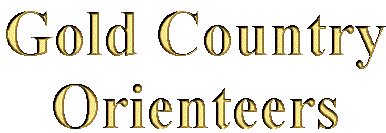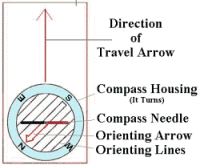Using a Compass
Using a compass in orienteering is not nearly as hard as it may seem. Here are the parts of a compass (right): the BASE is the clear plastic part to which every thing is attached. It will have a DIRECTION of TRAVEL ARROW on it and will probably have a ruler like scale on an edge or two. There will be a round COMPASS HOUSING that will be able to turn. It will have the letters N, E, S, and W for North, East, South, and West around the perimeter. Inside the COMPASS HOUSING there will be black parallel lines and an outline of an arrow called an ORIENTING ARROW. The part that makes it a compass is a COMPASS NEEDLE, usually painted Red and Black. The Red end always points to Magnetic North.

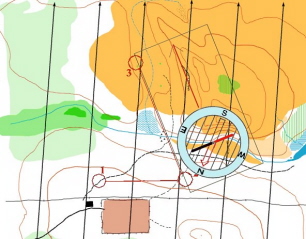
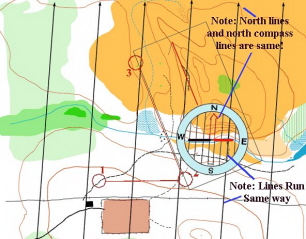
To see how to use the compass for Orienteering we are going to imagine that we are at control 2 on our map (above, left) and are going to control 3.
Placing our compass on the map (ignore the compass needle at this time) we align the edge of the compass base with the direction on the map we wish to go, making sure that the direction of travel arrow points in direction we want to go (above, center).
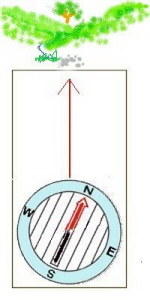
With the compass base aligned, we now turn our compass housing until the orienting lines are parallel to the magnetic north lines on the map (above, left) Make sure the orienting arrow and magnetic north lines point the same way.
Your compass is now set with the real world. Hold the compass level in front of you with the direction of travel arrow pointing away from you. Now turn your whole body around until the Needle is aligned in the orienting arrow (right) (red part of needle in red part of arrow). You are now facing towards station 3 in the real world. Pick a faraway landmark to which your direction of travel is pointing and walk toward that landmark. Repeat until destination is reached. Note: If you pick a landmark that is easy to keep in view, you can take the easiest route to it that is not necessarily a straight line.
Caution: Metal near the compass will throw its accuracy off, sometimes by a lot, so always be aware. And always keep your compass flat (parallel to the ground).
Back to How To Orienteer

